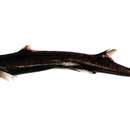Diagnostic Description
provided by Fishbase
Dark grey (Ref. 6577) or brown dorsally, black ventrally, with a distinct black streak above and behind pelvic fins; fins lighter; belly luminous (Ref. 26346). Small and slender with a moderately elongate caudal peduncle and with flank denticles mostly arranged in regular rows. The base of the pelvic flank marking is under the second dorsal-fin spine, the anterior branch is usually longer than the posterior branch, and the caudal marking is considerably longer than the precaudal marking (Ref. 6871).
- Recorder
- Cristina V. Garilao
Life Cycle
provided by Fishbase
Presumably ovoviviparous (Ref. 6871). Size at birth about 15 cm (Ref. 6871). Distinct pairing with embrace (Ref. 205).
- Recorder
- Cristina V. Garilao
Morphology
provided by Fishbase
Dorsal spines (total): 2; Dorsal soft rays (total): 0; Analspines: 0; Analsoft rays: 0
- Recorder
- Cristina V. Garilao
Trophic Strategy
provided by Fishbase
Found on the outer continental and insular shelves and upper slopes (Ref. 247, 75154). Benthopelagic at 183-823 m (Ref. 58302). Its luminescent belly may attract prey (Ref. 26346), which consists mainly of squid (reported to bite squid bigger than itself), small bony fishes, and shrimps (Ref. 247). Often caught in large schools which may suggest that the luminescence may also be used to keep the group together in the dark deep ocean (Ref. 26346). Feeds om myctophids and cephalopods (Ref. 58748).
Biology
provided by Fishbase
Found on the outer continental and insular shelves and upper slopes (Ref. 247). Its luminescent belly may attract prey (Ref. 26346), which consists mainly of squid (reported to bite squid bigger than itself), small bony fishes, and shrimps (Ref. 247). Often caught in large schools which may suggest that the luminescence may also be used to keep the group together in the dark deep ocean (Ref. 26346). Ovoviviparous (Ref. 205), size at birth about 15 cm (Ref. 6871).
- Recorder
- Kent E. Carpenter
Importance
provided by Fishbase
fisheries: of no interest
- Recorder
- Kent E. Carpenter
分布
provided by The Fish Database of Taiwan
分布於世界三大洋之部分溫帶暖水域及熱帶水域。臺灣則分布於東北部海域。
利用
provided by The Fish Database of Taiwan
一般為底拖網捕獲,魚體小型多做下雜魚用。
描述
provided by The Fish Database of Taiwan
體細長;頭短而寬扁;尾細長,尾柄無尾前凹窪和側脊;吻短,背視三角形,兩側斜直,前端圓弧;眼大,橫橢圓形,後端尖而有一缺刻;無瞬膜,眼距吻端比口裂距第一鰓裂之距離為近;鼻孔頗大,斜列,外側位,距吻端比距口裂近;鼻孔間距狹,比鼻孔稍大;;口裂淺弧形;上顎齒扁寬,五齒頭型,多行在使用,每側每行13齒;下顎齒扁狹,單齒頭型,齒頭外斜,邊緣光滑,內緣約與下顎平行,外緣深凹,一行在使用,每側21齒;噴水孔頗大,卵圓形,直徑約等於眼徑的1/3,位於眼睛後上方,到眼睛之距離約等於眼徑的1/2;鰓裂狹小;盾鱗細長彎曲;與體軸並行,呈線狀排列。背鰭二枚,各具一硬棘;第一背鰭小,起點在胸鰭後緣末端後上方,距吻端比距第二背鰭稍遠,第一背鰭基底末端到第二背鰭起點之距離約等第二背鰭基底末端到尾鰭上葉起點的兩倍;第一背鰭之硬棘短,具側溝槽,棘約等於鰭前緣長的1/2,到吻端之距離遠小於到尾鰭上葉起點之距離;上角圓,後角尖突,末端距腹鰭起點甚遠;第二背鰭較大,起點在腹鰭基底末端後上方,距尾鰭起點比距第一背鰭近,硬棘較長,具側溝槽,後緣深凹,後角延長尖突;尾鰭長中等;上葉發達,後緣有一缺刻;腹鰭低平,前後緣連續、呈半弧形;鰭腳寬扁,後端尖突;胸鰭中大,呈長方形,邊緣頗平直,外角和內角圓鈍;背側面有剛毛狀盾鱗,排列成緊密縱行線紋;腹面上的鱗片不呈線紋。背側面暗灰褐色;腹面黑色;在腹鰭上方深色翼斑向前延伸的前分支長於往後分支的長度,尾鰭末端黑色,各鰭淡褐色;上眼瞼後部白色,前腦區白色。
棲地
provided by The Fish Database of Taiwan
生活於大陸棚和島嶼周遭斜坡近底水深150-1,200公尺處。卵胎生。攝食槍烏賊和小型硬骨魚類。最長約47公分,雄成魚長29-42公分。
Blackbelly lanternshark
provided by wikipedia EN
The blackbelly lanternshark or lucifer shark, Etmopterus lucifer, is a shark of the family Etmopteridae, found around the world in tropical to temperate seas, at depths between 150 and 1,250 meters.[2] Its length is up to 47 centimeters.[2] This species consumes mesopelagic cephalopods, fishes, and crustaceans.[3]
Blackbelly lanternsharks are ovoviviparous.[2] They exhibit bioluminescence.[4]
In June 2018 the New Zealand Department of Conservation classified the blackbelly lanternshark as "Not Threatened" with the qualifiers "Data Poor" and "Secure Overseas" under the New Zealand Threat Classification System.[5]
References
-
^ Finucci, B.; Ebert, D.A.; Schaaf-Da Silva, A (2018). "Etmopterus lucifer". IUCN Red List of Threatened Species. 2018: e.T161517A889953. doi:10.2305/IUCN.UK.2018-2.RLTS.T161517A889953.en. Retrieved 18 November 2021.
-
^ a b c Carpenter, Kent E.; Capuli, Estelita Emily (2019). "Etmopterus lucifer Jordan & Snyder, 1902 Blackbelly lanternshark". Fishbase. Retrieved 19 January 2019.
-
^ Roberts, Clive; Stewart, A. L.; Struthers, Carl D.; Barker, Jeremy; Kortet, Salme; Freeborn, Michelle (2015). The fishes of New Zealand. Vol. 2. Wellington, New Zealand: Te Papa Press. p. 143. ISBN 9780994104168. OCLC 908128805.
-
^ "Glow-in-the-dark sharks found off New Zealand coast". BBC News. 3 March 2021. Retrieved 6 March 2021.
-
^ Duffy, Clinton A. J.; Francis, Malcolm; Dunn, M. R.; Finucci, Brit; Ford, Richard; Hitchmough, Rod; Rolfe, Jeremy (2018). Conservation status of New Zealand chondrichthyans (chimaeras, sharks and rays), 2016 (PDF). Wellington, New Zealand: Department of Conservation. p. 10. ISBN 9781988514628. OCLC 1042901090.

- license
- cc-by-sa-3.0
- copyright
- Wikipedia authors and editors
Blackbelly lanternshark: Brief Summary
provided by wikipedia EN
The blackbelly lanternshark or lucifer shark, Etmopterus lucifer, is a shark of the family Etmopteridae, found around the world in tropical to temperate seas, at depths between 150 and 1,250 meters. Its length is up to 47 centimeters. This species consumes mesopelagic cephalopods, fishes, and crustaceans.
Blackbelly lanternsharks are ovoviviparous. They exhibit bioluminescence.
In June 2018 the New Zealand Department of Conservation classified the blackbelly lanternshark as "Not Threatened" with the qualifiers "Data Poor" and "Secure Overseas" under the New Zealand Threat Classification System.
- license
- cc-by-sa-3.0
- copyright
- Wikipedia authors and editors
Description
provided by World Register of Marine Species
Found on the outer continental and insular shelves and upper slopes. Feeds on squids, shrimps, bony fishes including lanternfishes. Development presumably ovoviviparous.
Froese, R. & D. Pauly (Editors). (2023). FishBase. World Wide Web electronic publication. version (02/2023).
- license
- cc-by-4.0
- copyright
- WoRMS Editorial Board
Habitat
provided by World Register of Marine Species
Known from seamounts and knolls
Stocks, K. 2009. Seamounts Online: an online information system for seamount biology. Version 2009-1. World Wide Web electronic publication.
- license
- cc-by-4.0
- copyright
- WoRMS Editorial Board

